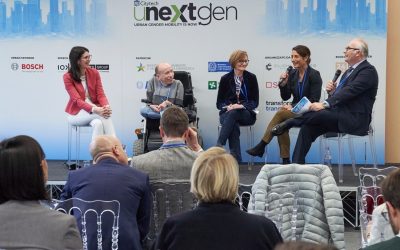Hello Alex! Today you are going to shed light on the two new product features «multiple journey offers» and «multimodal». Let’s start by taking a closer look at the term «multiple ride offers». What exactly is it?
«Multiple ride offers» is a new feature of the platform that allows our customers to offer passengers up to four on-demand ride offers at the same time in their products. Passengers can thus select the journey that suits them perfectly. In concrete terms, this means that if a passenger requests a ride for 09:45, for example, and all shuttles are already fully booked for the specific time, the passenger will be offered alternatives for pick-up such as 09:20, 09:55 and 10:05. The passenger can now choose and book the best journey offer. In addition to the possibility of presenting the customer with several on-demand travel offers, «multiple ride offers» also enables us to present public transport alternatives.
So multiple ride offers means that we offer the passenger different on-demand ride offers as well as having the basis to be able to show alternatives with other public transport services?
Exactly. In addition to on-demand rides, we can also show passengers alternative public transport connections. These can be direct connections with buses, underground trains, suburban trains or trams, but also combined public transport connections with transfers.
In which scenarios does the new multimodal feature take effect and show other means of public transport in addition to the on-demand shuttles?
In the first use case, public transport connections can always be displayed next to on-demand journeys. The transport operator can choose the sorting of the display of these journey alternatives. It is possible to always display the on-demand journey first, to choose a descending sorting according to start time, or to sort according to relevance. Relevance means that various parameters can be set at product level to determine which public transport connections are considered relevant alternatives for the passenger. This is used to calculate a relevance score, which then determines the order in which the alternatives are displayed.
Another use case is that only public transport connections are displayed if no on-demand journeys are found. For example, all shuttles may already be booked, but acceptable public transport alternatives exist for the passenger request. If the operator wants to be even more restrictive towards the on-demand offer and put the existing local public transport offer in the foreground, the feature also allows the operator to indicate in interaction with the parallel trip prohibition function that the passenger is not allowed to book an on-demand trip in this time period because there are suitable alternative public transport solutions for his trip request.
These use cases are of course not only applicable individually, but can also be combined with each other.
That sounds exciting! Is it also possible to not only have a public transport alternative with one means of transport displayed, but also transfer connections in an intermodal travel chain?
Partly. So far, public transport connections with transfers can already be displayed. This means that the passenger is shown, for example, a combined journey from the suburban railway and bus, including the necessary change. Another important implementation step is the combination of an on-demand journey with the subsequent use of a public transport service, the classic delivery or pick-up case for the on-demand shuttle, so to speak. This is not yet possible. Nevertheless, we have already completed the first development stage of one of our core development topics and are pleased to have reached the next milestone towards our vision.
… so the new feature will ensure that an even stronger link is created between classic public transport and on-demand services?
That’ s right. From now on, our operators can decide for themselves how far they want to integrate the on-demand product into their local public transport offer.
Possibilities are an on-demand product as an additional supplement to the existing public transport system or one that only operates if no suitable public transport connection can be offered to the passengers. However, the on-demand product can also be more expensive if a parallel public transport connection exists for the same trip request, so the classic comfort surcharge comes into play optimally here.
These are the decisions that the operator now makes. But what does the new feature mean for the end customer in ecological and economic terms?
As a passenger, I now also have a much greater individual scope for decision-making. From an economic point of view, the probably cheaper option of public transport is now presented to me directly, so that I can actively decide in favour of it. From an ecological point of view, I am doing something good for the environment by perhaps taking a walk to reach public transport. Our goal as ioki is to make the existing means of transport useful and to supplement or replace them only when necessary. Each individual user can now fulfil his or her responsibility even more easily.
To conclude, let’s take a look into the future. What further developments are planned for the product feature?
We have just reached the first stage of expansion. In this stage, we show the departure time of the proposed public transport, the travel time, the exact means of transport and the walking time for the public transport alternatives. In the second expansion stage, this will be supplemented by a detailed view of the connection. The passenger will then also be shown the arrival time of his or her means of transport, the walking distance (incl. footpath navigation) and the exact stops for getting off and changing.
The third expansion stage then already includes the intermodal journey chains, which contain an on-demand journey as a delivery or pick-up connection. These will even be able to provide limited journey information beyond the on-demand operating area.
Alex, thank you very much for your time!



